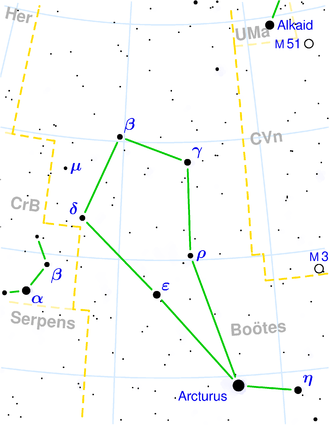NGC 5463
| Galaxy NGC 5463 |
|
|---|---|

|
|
| SDSS recording | |
| AladinLite | |
| Constellation | Bear keeper |
|
Position equinox : J2000.0 , epoch : J2000.0 |
|
| Right ascension | 14 h 06 m 10.5 s |
| declination | + 09 ° 21 ′ 12 ″ |
| Appearance | |
| Morphological type | S? |
| Brightness (visual) | 12.9 mag |
| Brightness (B-band) | 13.8 mag |
| Angular expansion | 1.2 ′ × 0.5 ′ |
| Position angle | 49 ° |
| Surface brightness | 12.2 mag / arcmin² |
| Physical data | |
| Redshift | 0.023943 +/- 0.000097 |
| Radial velocity | 7178 +/- 29 km / s |
|
Stroke distance v rad / H 0 |
(321 ± 23) x 10 6 ly (98.3 ± 6.9) Mpc |
| history | |
| discovery | Wilhelm Herschel |
| Discovery date | March 19, 1784 |
| Catalog names | |
| NGC 5463, 5463A • UGC 9017 • PGC 50299 • CGCG 074-102 • MCG + 02-36-40 • GC 3780 • H III 58 • LDCE 1042 NED007 | |
NGC 5463 , also called NGC 5463A , is a 12.9 mag bright galaxy of the Hubble type S? in the constellation Bear Keeper and about 321 million light years from the Milky Way. Together with the non-NGC object NGC 5463B, it forms an optical double galaxy.
The object was discovered on March 19, 1784 by Wilhelm Herschel with an 18.7-inch reflector telescope, who described it as "eF, S, verified with 240 power and lE".
